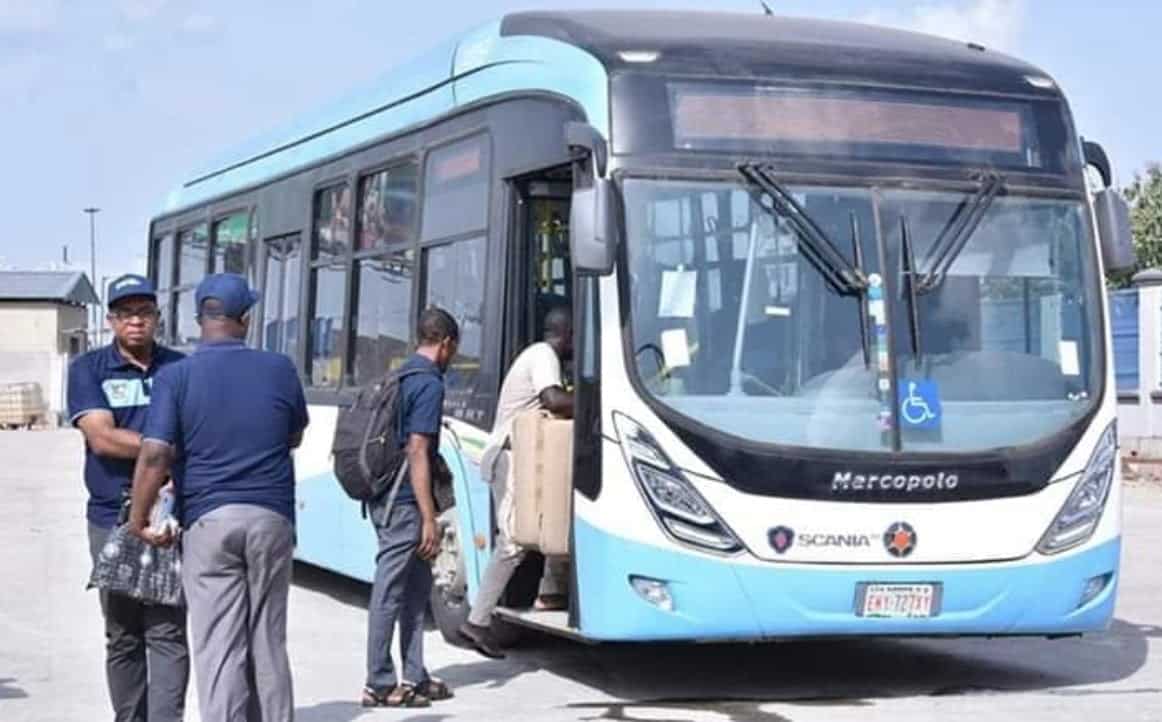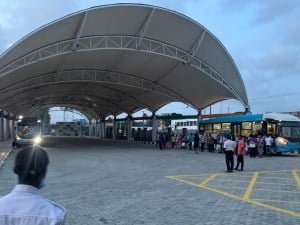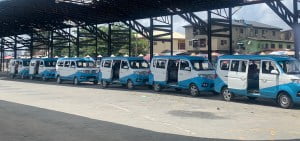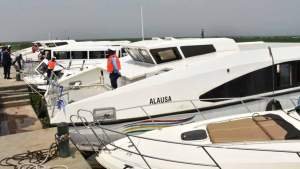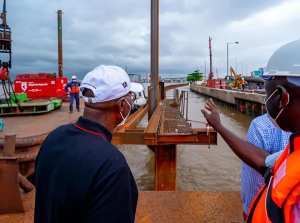Lagos State, Nigeria’s commercial and increasingly urbanised centre with over 20 million people, is on a low-lying coastal plain. Its location and rising urbanisation make the state particularly vulnerable to the impacts of climate change as well as a big contributor to greenhouse gases emissions.

To mitigate the effect of climate change in Lagos, the state joined C40 Cities – a network of world’s megacities chalking out climate action paths – in committing to the development and implementation of a multi-pronged Climate Action Plan (CAP) in line with the goals of the Paris Agreement. The ultimate goal, according to the plan, is a net zero-carbon Lagos by the year 2050.
The CAP document produced by the Lagos State officials with support from C40 Cities identified the majority of Lagos’ greenhouse gas (GHG) emissions to be generated from three key sectors: energy, waste and transport as they account for 90% of the total greenhouse gas emissions.
A GHGs emissions inventory developed in 2015, based on the global protocol for community-scale greenhouse gas for cities as contained in the CAP document, showed that in 2015 Lagos State generated emissions of 26,443,656 tCO2e, or 1.3 tCO2e per capita and it has been projected to triple by 2050 if no climate actions are taken.
Transportation and Climate Change
GHGs emissions from the transport sector are a major contributor to climate change globally and particularly in Africa where mass transit systems remain inefficient.
Climate change also affects the transport sector as it causes infrastructural damage, as well as disruption and delay of transport businesses in global supply chains networks.
An Environmentalist and Chairman of Lagos State Urban Forest and Animal Shelter Initiative, LUFASI, Desmond Majekodunmi, said that emissions from the transport sector do not only have an impact on the climate but also on people’s health.
“The transport sector is one of the major contributors, not just to global warming but also air pollution because it burns fossil fuels… and a WHO data shows that air pollution causes an estimated seven million deaths.”
He added that the number of cars is not necessarily the factor driving up emissions, “When you compare the numbers of cars on Lagos roads to London for instance, you will be surprised that London has more cars but we generate huge emissions due to the high numbers of bad cars, old private commercial vehicles etc.”
Mitigating Climate Change Through Transportation in Lagos
In a bid to address the issues of climate change, Lagos state in 2018 established a unit (now a fully-fledged department) within the Ministry of the Environment and Water Resources to coordinate its climate change response strategies.
The State Commissioner for Environment and Water Resources, Mr. Tunji Bello, said eco-relevant reforms in the area of transportation are key to the state’s climate actions.
According to him, the flag-off construction of the Lagos railway project by the Sanwo-Olu led-administration in addition to several government innovations in the water transportation system is geared towards a healthier and low-emission Lagos.
Speaking on the impediments to the realisation of the net zero-carbon emissions target by 2050, Mr. Bello said, “the projections can only be unsuccessful if the government fails to keep to its action plan which we do not intend to do.”
But residents said that the mass transport system in the state is inefficient and they would prefer to use their private cars, threatening carbon neutral ambitions of the state.
A Lagos-based program manager, Ridwan Ayinla, who spends nothing less than three hours driving to work daily questioned the government’s inability to fix public transportations.
“In developed countries, people rarely drive to work every time because they have a system that works. Passengers have options of commuting smoothly either by trains or mass transit buses.
“If clean BRT buses, standard/shuttle buses, are available on all major roads with good air conditioning system, majority of commuters would ride to work in the buses because the traffic situation in the state doesn’t even make driving fun,” he said.
Another resident, Ibrahim, who lives in the Ketu area of the state and works on the island, said the uncertainty in the travel time discouraged him from using the service.
He said, “The BRT system is not delivering as it should be, commuters still wait longer at the bus terminal before getting buses during peak periods. Imagine getting to the bus terminal at past 5 pm after work and you don’t get to leave the terminal until after 1 or 2 hours.
“The state must work out plans to make the service more effective. In Europe, you already know when the bus will arrive at the station and when it will leave irrespective of the number of passengers available at the time. The only way I think the government can solve this problem is by carrying out an unbiased survey/poll asking commuters on what they need to do to make the service better and also open more connecting roads to reduce traffic on the major roads.”
Key Transport Emissions Mitigation Strategies
In the Climate Action Plan document, the state government plans to reduce the emissions caused by the transport sector by “Expanding the BRT network from the current three lines to a total of 14; Deploy low emission buses; Construct four bus terminal gateway hubs; Implement physical and spatial development plans that require developers to incorporate low-emission technologies in their proposed development plans.
“Construct the light rail transit (LRT) system with six lines codenamed Red, Blue, Green, Yellow, Purple, Brown and Orange lines that will link the major population and activity centres in the state; Adopt and implement the Non-motorised transport policy including improvements to ferry safety and services; Build pilot scheme for improved walkability; Advocacy campaigns on the safety of pedestrians and cyclists.”
Others are; “To provide incentives and invest in infrastructure to promote the uptake of ultra-low emission vehicles (including electric, hybrid, hydrogen cars, motorcycles and freight vehicles), Impose restrictions on the use of high-polluting vehicles and provision of electric vehicle charging infrastructure in the state; To encourage the shift of freight from road to rail by establishing rail links between major ports, industrial centres and airports.”
With the above mitigation actions in the transport sector with a 2-5 years implementation timeline as contained in the CAP document, the state wants to achieve a 80% mode shift from private cars to BRT, 52% of buses are electric, 20% of motorcycles and 8% of taxis are electric, increased use of biodiesel in freight services, 50% of motorcycles replaced with e-bicycles and 2% of trips by privately owned cars by the year 2050.
Efforts to reach the State Commissioner for Transportation, Dr. Frederic Oladeinde by this reporter via calls and text messages for further information on the implementation approach towards the 2050 net zero-emission target proved abortive.
Mitigation Projects
Governor Babajide Sanwo-Olu had in the last one year commissioned three BRT terminals. They are; Yaba Bus Terminal, MMA Mafoluku Bus Terminal, Oyingbo Bus Terminal.
This reporter visited the Yaba Bus Terminal to have a first hand experience of the facility. The terminal which began operation in August 2021, services Ikorodu, Ajah, Oshodi, Iyana- Ipaja and Victoria Island areas of the state.
The Governor in May 2021, launched the First and Last Mile (FLM) Bus Scheme. A LAMATA Supervisor, Surulere (Zone 2), Mr. Peter said that his branch took delivery of over 40 FLM buses. He stated that the buses have been in operation for about four months and are still expecting more.
The state government in March 2021, added eight new ferries to the existing fleet of boats already servicing several corridors on Lagos waterways. The technology-enhanced and safer speed ferries have the capacity of commuting 40 to 60 passengers per trip.
Newly procured high capacity Boats commissioned by Lagos State Governor, Babajide Sanwo-Olu, on Tuesday, June 22, 2021. Photo: LASG
READ ALSO: Has Lagos Lockdown Affected Climate Change?
A major transportation project, the Lagos light rail that has dragged for decades is finally coming to life as Governor Sanwo-Olu in April, flagged off the construction of the 37km Red Rail Line linking Agbado to Marina. The Red Line is expected to move its first passengers in the fourth quarter of 2022, as the state works towards bringing the first phase of the 27km Blue Line linking Okokomiko to Marina to passenger operation also in 2022. The trains are Electric Multiple Units (EMUs) which are emissions-free.
Governor Babajide Sanwo-Olu inspecting the rail corridor on Saturday, September 25, 2021. Photo: Lagos State Government
The Lagos State House of Assembly in March passed the Lagos State Transport Sector Reform Bill, 2021. The bill was for a law to amend the Lagos State Transport Sector Reform Law 2018. The Bill among others prohibits the use of motorcycles and tricycles with an engine capacity of 200cc on major highways within Lagos.
Transport Specialist Recommendations
In terms of transportation, the state has made investments in infrastructure and increased its fleet of public transport. However, the investments have made little or no impact due to the population growth and rapid urbanisation.
Colin Brader, an International Director at Integrated Transport Planning Ltd, urged the government to explore other modes of transportation.
“With the BRT system, the government has got so much right. Although, BRT cannot provide a solution for all mobility needs but as it develops, more of people’s transport needs will be met. If we cast our minds back to pre-BRT, people were resigned to using Danfos and Molue with low levels of service often at high cost and environmentally unfriendly.
“For Lagos to achieve an 80% mode shift of private cars to BRT by 2050, the government must develop a public transport network that is integrated and meets the needs of users. BRT is just part of that network, the conventional bus, LRT and potentially other public transport modes would contribute. At present, people buy cars not only to meet their mobility needs but also as it is a symbol of success – public transport can be a symbol if it’s of good quality and standard. Achieving this target will require good design, appropriate institutional regulatory support and committed politicians,” Mr. Brader said.
This story was produced under the NAREP Climate Change Media 2021 fellowship of the Premium Times Centre for Investigative Journalism.




